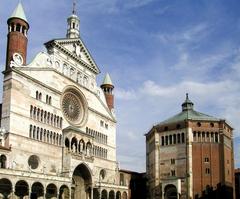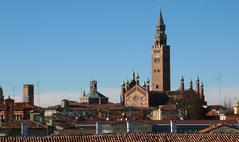Teatro Comunale Ponchielli Cremona: Visiting Hours, Tickets, and Historical Significance
Date: 04/07/2025
Introduction
Nestled in the heart of Cremona, Italy, the Teatro Comunale Ponchielli stands as a beacon of musical tradition, architectural grandeur, and cultural vibrancy. Since its establishment in 1747, this historic opera house has evolved from the vision of local nobles into one of Northern Italy’s most prestigious venues, blending neoclassical and late-baroque design with modern technologies. Renamed after Amilcare Ponchielli, the famed Cremonese composer, the theatre today not only celebrates opera but also serves as a dynamic hub for artistic innovation and community engagement. Complemented by nearby attractions like the Torrazzo bell tower, Cremona Cathedral, and the Stradivari Museum, a visit to Teatro Ponchielli is essential for anyone exploring the rich heritage of Cremona (Teatro Ponchielli Official Website; Monteverdi Festival Cremona; Italy Magazine; AgendaOnline.it).
Historical Overview
Origins and Early Development (1747–1806)
The theatre’s foundations were laid in 1747 when Cremonese nobles commissioned Giovanni Battista Zaist to design a permanent home for the city’s burgeoning cultural scene. The resulting Teatro Nazari featured a U-shaped auditorium, four tiers of boxes, and a gallery—a configuration emblematic of 18th-century Italian theatre design. The venue quickly became the focal point of Cremona’s social and artistic life, hosting operas, plays, and concerts that drew audiences from across the region. In 1785, the ownership shifted to the Palchettisti (box-holders), renaming it “Teatro della Società” or “Teatro delle Nobile Associazioni,” signifying its status as a hub for Cremona’s elite (Monteverdi Festival Cremona).
Destruction and Rebirth (1806–1824)
Disaster struck in 1806 when a fire destroyed the original wooden structure. Renowned theatre architect Luigi Canonica was tasked with rebuilding, and by 1808, the “Teatro della Concordia” emerged, boasting a horseshoe-shaped auditorium and a large stage. This design established the theatre’s reputation for technical excellence. Another fire in 1824 prompted further restoration by Faustino Rodi and Luigi Voghera, restoring and enlarging the venue (Italy Magazine).
The Ponchielli Era and 19th-Century Flourishing
At the turn of the 20th century, the theatre was renamed in honor of Amilcare Ponchielli, Cremona’s celebrated composer known for “La Gioconda.” The theatre’s architectural features—including its Neoclassical façade, gilded interior, and ornate boxes—remain largely intact from this era, emphasizing its commitment to the arts and its role as a premier cultural institution (Italy Magazine).
Modernization and Present-Day Significance
Acquired by the Municipality in 1986, Teatro Ponchielli underwent extensive renovations and technological upgrades starting in 1989, transforming it into one of Italy’s most modern yet historically preserved venues. Managed by a dedicated foundation since 2003, the theatre continues to host a diverse range of performances and community events. Recent restorations, such as the foyer’s historic flooring in 2023, ensure the venue remains both authentic and accessible (Monteverdi Festival Cremona; Italy Magazine).
Architectural Highlights
- Auditorium: Horseshoe-shaped with four orders of boxes and a gallery for optimal acoustics and visibility, preserving the intimacy and social hierarchy of traditional Italian theatres.
- Stage: Among the largest in Italy, with a timber frame structure dating to the early 1800s, enabling complex productions and technical versatility (Wikipedia).
- Decorative Details: Gilded stuccoes, papier-mâché medallions, and a historic curtain by Antonio Rizzi provide visual splendor and artistic distinction.
- Foyer: Recently restored, featuring marble finishes and classical columns, welcoming audiences into a setting that blends history and modern comfort.
- Unique Spaces: The “inscriptions corner,” where generations of artists have left their mark, and a backstage laboratory for handcrafted stage design (Teatro Ponchielli Official Website).
Visiting Hours, Tickets, and Guided Tours
- Box Office: Open Tuesday to Saturday, 10:00 AM–1:00 PM and 3:00 PM–6:00 PM (in-lombardia.it).
- Guided Tours: Available by reservation, generally during box office hours. Tours last about 45 minutes, covering the auditorium, stage, royal box, and backstage areas. Cost: €5.00 (full), €3.00 (reduced; students, seniors, groups) (turismocremona.it).
- Performance Tickets: Purchase online via the official website or at the box office. Prices vary by event and seating; reduced rates are available for students, seniors, and groups.
- Reservations: For tours and group bookings, contact +39 0372 022010 / +39 0372 022011 or email [email protected].
Accessibility and Visitor Services
- Physical Accessibility: Wheelchair access, accessible seating, ramps, and elevators.
- Sensory Accessibility: The “OPEN” project provides adapted performances for visitors with sensory disabilities, including audio descriptions and multisensory experiences (apemusicale.it).
- Amenities: Cloakroom, restrooms, and program sales. Nearby cafés and restaurants are available on Corso Vittorio Emanuele II.
- Photography: Allowed in foyer and public areas; restricted during performances.
Performance Calendar and Special Events
- Opera and Music: From October to December, operatic productions—such as Donizetti’s L’elisir d’amore and Verdi’s Nabucco—headline the calendar (operalombardia.it).
- Festivals: The annual Monteverdi Festival draws international talent and audiences (Monteverdi Festival Cremona).
- Education: Programs and workshops for schools, families, and young audiences, including the “Oltreibanchi” series.
- Special Tours: “Guida all’ascolto” listening guides and backstage experiences are offered seasonally (apemusicale.it).
Travel Tips and Nearby Attractions
- Location: Corso Vittorio Emanuele II, 52, 26100 Cremona—steps from Piazza del Comune and the Violin Museum.
- Getting There: Easily accessible by train, local bus, taxi, or car; nearby parking available.
- Best Times: Visit during the opera season (October–December) or for special events for a full experience. Weekdays are less crowded.
- Nearby Sights: Explore the Torrazzo bell tower, Cremona Cathedral, Stradivari Museum, and the city’s historic piazzas (cultureactivities.com).
Frequently Asked Questions (FAQ)
What are the visiting hours?
Box office: Tuesday–Saturday, 10:00–13:00 and 15:00–18:00. Guided tours and visits require advance booking (teatroponchielli.it).
How do I buy tickets?
Purchase online or at the box office. Early booking is recommended, especially during peak season.
Is the theatre accessible for wheelchair users?
Yes, with wheelchair access and sensory-friendly performances. Contact the theatre for specific needs.
Are guided tours available?
Yes, by reservation, offering insights into the theatre’s history, architecture, and backstage.
What are the main performances in the 2025/26 season?
Highlights include operas by Donizetti, Verdi, Bizet, Bellini, and participation in the Opera Lombardia circuit (operalombardia.it).
Summary and Visitor Recommendations
Teatro Comunale Ponchielli is a jewel of Cremona’s cultural landscape, celebrated for its architectural beauty, storied history, and commitment to both tradition and innovation. With its accessible facilities, engaging performances, and integration within the city’s vibrant heritage, the theatre promises visitors a memorable and enriching experience.
To maximize your visit:
- Check the official Teatro Ponchielli website for up-to-date schedules, ticketing, and visitor information.
- Reserve guided tours in advance for deeper insights.
- Download the Audiala app for event updates and exclusive content.
- Pair your theatre experience with visits to Cremona’s other historical and musical sites.
Sources and Further Reading
- Monteverdi Festival Cremona
- Italy Magazine – Teatro Ponchielli: Cremona’s Opera House
- AgendaOnline.it – Teatro Amilcare Ponchielli Cremona
- Ponchielli.org – Storia
- SocialMediaLife.it – Stagione lirica 2025–2026
- TurismoCremona.it – Monteverdi Festival Cremona
- OperaWire – Teatro Ponchielli’s 2025–26 Season
- Teatro Ponchielli Official Website – History
- Wikipedia – Teatro Ponchielli

